I already took a look at the Radeon RX 7800 XT reference card this morning so we have an idea of how the new 7800 XT GPU performs. But most people aren’t picking up the stock-clocked reference cards, they run the partner cards with larger coolers and are overclocked. To get an idea of how the 7800 XT performs in that situation, XFX sent over their Merc 319 7800 XT Black. I’ve been a fan of XFX’s clean styling for the last few generations, they haven’t done the standard “gaming” styling that packs a bunch of angles into the design with multiple shades of grey. They have simple smooth fan shrouds and stick mostly with black. I’m hoping that the Merc 319 7800 XT Black is going to continue that. So let’s dive in and see what the Merc 319 7800 XT Black is all about and how it performs.
Product Name: XFX Merc 319 7800 XT Black
Review Sample Provided by: XFX
Written by: Wes Compton
Amazon Affiliate Link: HERE
AMDs new RX 7700 XT and 7800 XT
At Gamescom this year AMD announced two new GPUs to fill in a few big gaps in their current 7000 Series GPU lineup. Before the announcement, they had the RX 7600, RX 7900 XT, and RX 7900 XTX. That covered the higher end of the market with their 4K focused cards and the 7600 which is a mid-range 1080p focused card. The two new models fit in the middle with a 1440p resolution focus. While 1080p is still the most widely used resolution on Steam hardware surveys, the 1440p resolution is growing quickly, AMD highlighted this in the presentation pointing out a 44% growth year on year on the Steam hardware survey.
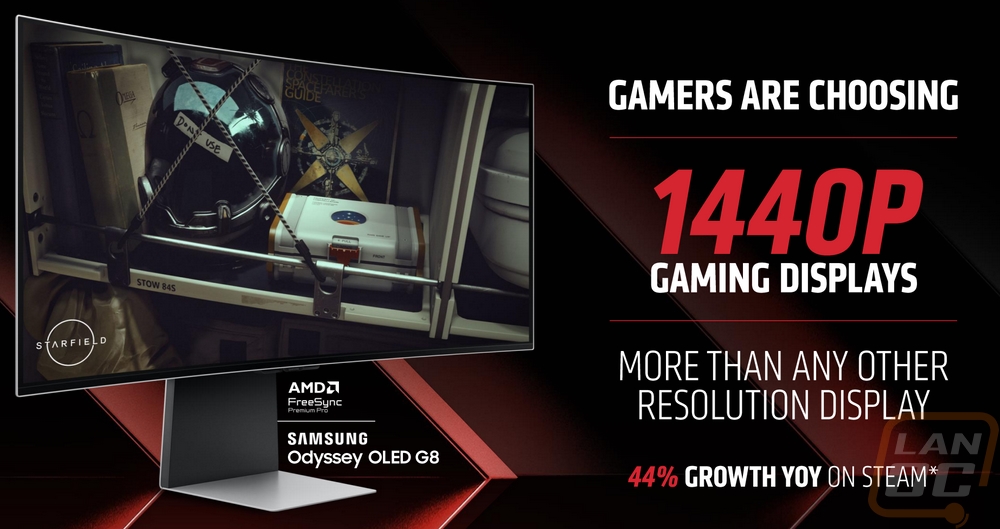
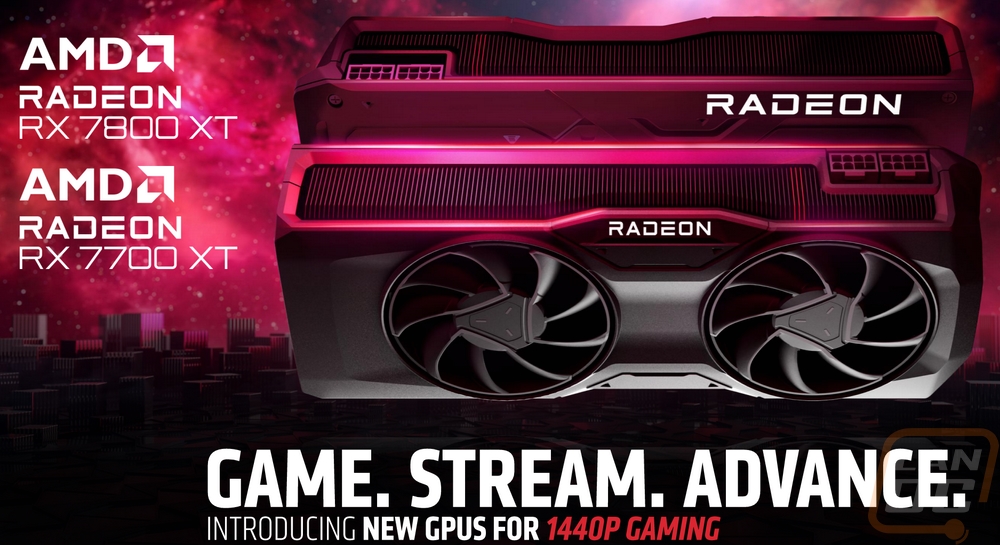
To get a look at where the new RX 7700 XT and RX 7800 XT sit spec wise I have the specs from the AMD briefing as well as a full breakdown that includes the RX 7600 and RX 7900 XT which for the 7000 Series sit above and below the two cards as well as the RX 6700 XT and RX 6800 which are the comparable cards from last generation. Both the 7700 XT and the 7800 XT have the same 5nm and 6nm combination of manufacturing process that the 7900 XT has. The two GPUs have the same die size and transistor count with them sharing the same base GPU but the compute units and the stream processor counts show us that it has been cut down slightly for the 7700 XT compared to the 7800 XT. The 7800 XT is right with the 6800 in stream processors as well as compute units and ray accelerators but last generation's cards didn’t have the AI accelerators which the 7800 XT has 120 and the 7700 XT has 108. The 7800 XT has a slightly lower game GPU clock than the 7700 XT with it at 2124 MHz to 2171 MHz on the 7700 XT. The same goes for the boost clock which the 7800 XT can see up to 2430 MHz whereas the 7700 XT can do up to 2544 MHz. The single precision performance numbers give us an idea of what the lower clock speeds but higher core counts translate to. The 7700 XT can do up to 35 TFLOPS whereas the 7800 XT is slightly higher at 37 TFLOPS. The 7900 XT is way out ahead of that at 51 TFLOPS and the 7600 is well below the two at 21 TFLOPS. Then both the 6700 XT and the 6800 are well below the 7600 at 13.21 TFLOPS and 16.17 TFLOPS.
The 7700 XT has 48 MB of the 2nd generation Infinity Cache whereas the 7800 XT has 64 MB. Then for memory, the 7700 XT has 12GB of GDDR6 memory to the 16GB on the 7800 XT. They also have different memory bus interfaces with a 192-bit interface for the 7700 XT and 256-bit for the 7800 XT and the memory on the 7800 XT is also clocked faster with it running at 19.5 Gbps and 18 Gbps for the 7700 XT. Overall the higher cache and everything else translates to the 7700 XT having an effective memory bandwidth of 1995.3 GB/s to the 2708.4 GB/s for the 7800 XT. Both cards have a traditional PCIe 4.0 x16 interface, not the x8 that the RX 7600 had. Then for power, the two cards do have different total board power ratings with the 7700 XT at 245 watts and the 7800 XT at 263 watts. AMD also announced the base pricing of the cards at Gamescom with the RX 7700 XT at $449 and the RX 7800 XT at $499. The 7800 XT is available in a reference design directly from AMD as well as designs from their partners but the 7700 XT doesn’t have a reference design and will only be available with the partner designs.
|
Specifications |
RX 7600 |
RX 6700 XT |
RX 7700 XT |
RX 6800 |
RX 7800 XT |
RX 7900 XT |
|
Architecture |
RDNA 3 |
RDNA 2 |
RDNA 3 |
RDNA 2 |
RDNA 3 |
RDNA 3 |
|
Manufacturing Process |
6nm |
7nm |
5nm GCD + 6nm MCD |
7nm |
5nm GCD + 6nm MCD |
5nm GCD + 6nm MCD |
|
Transistor Count |
13.3 Billion |
17.2 Billion |
28.1 Billion |
26.8 Billion |
28.1 Billion |
57.7 Billion |
|
Dia Size |
204 mm² |
335 mm² |
200mm² GCD 150mm² MCD |
520 mm² |
200mm² GCD 150mm² MCD |
529 mm² |
|
Compute Units |
32 |
40 |
54 |
60 |
60 |
84 |
|
Ray Accelerators |
32 |
40 |
54 |
60 |
60 |
84 |
|
AI Accelerators |
64 |
-- |
108 |
-- |
120 |
168 |
|
Stream Processors |
2048 |
2560 |
3456 |
3840 |
3840 |
5376 |
|
Game GPU Clock |
2250 MHz |
2424 MHz |
2171 MHZ |
1815 MHZ |
2124 MHz |
2025 MHz |
|
Boost GPU Clock |
Up to 2655 MHz |
Up to 2581 MHz |
Up to 2544 MHz |
Up to 2105 MHz |
Up to 2430 MHz |
Up to 2394 MHz |
|
Peak Single Precision Perf. |
Up to 21 TFLOPS |
Up to 13.21 TFLOPS |
Up to 35 TFLOPS |
Up to 16.17 TFLOPS |
Up to 37 TFLOPS |
Up to 51 TFLOPS |
|
Peak Half Precision Perf. |
Up to 43 TFLOPS |
Up to 26.43 TFLOPS |
Up to 70 TFLOPS |
Up to 32.33 TFLOPS |
Up to 74 TFLOPS |
Up to 103 TFLOPS |
|
Peak Texture Fill-Rate |
Up to 339 GT/s |
Up to 413 GT/s |
Up to 550 GT/s |
Up to 505.2 GT/s |
Up to 583 GT/s |
Up to 804 GT/s |
|
ROPs |
64 |
64 |
96 |
64 |
96 |
192 |
|
Peak Pixel Fill-Rate |
Up to 169 GP/s |
Up to 165.2 GP/s |
Up to 244 GP/s |
Up to 202.1 GP/s |
Up to 233 GP/s |
Up to 459 GP/s |
|
AMD Infinity Cache |
32 MB (2nd Gen) |
96 MB (1st Gen) |
48 MB (2nd Gen) |
128 MB (1st Gen) |
64 MB (2nd Gen) |
80 MB (2nd Gen) |
|
Memory |
8GB GDDR6 |
12GB GDDR6 |
12GB GDDR6 |
16GB GDDR6 |
16GB GDDR6 |
20GB GDDR6 |
|
Memory Speed |
18 Gbps |
16 Gbps |
18 Gbps |
16 Gbps |
19.5 Gbps |
20 Gbps |
|
Effective Memory Bandwidth w/AMD Infinity Cache |
Up to 476.9 GB/s |
Up to 1278.0 GB/s |
Up to 1995.3 GB/s |
Up to 1664.2 GB/s |
Up to 2708.4 GB/s |
Up to 2900 GB/s |
|
Memory Bus Interface |
128-bit |
256*bit |
192-bit |
256-bit |
256-bit |
320-bit |
|
PCIe Interface |
PCIe 4.0 x8 |
PCIe 4.0 x16 |
PCIe 4.0 x16 |
PCIe 4.0 x16 |
PCIe 4.0 x16 |
PCIe 4.0 x16 |
|
Total Board Power |
165W |
230W |
245W |
250W |
263W |
300W |
|
Launch MSRP |
$269 |
$479 |
$449 |
$649 |
$499 |
$899 |
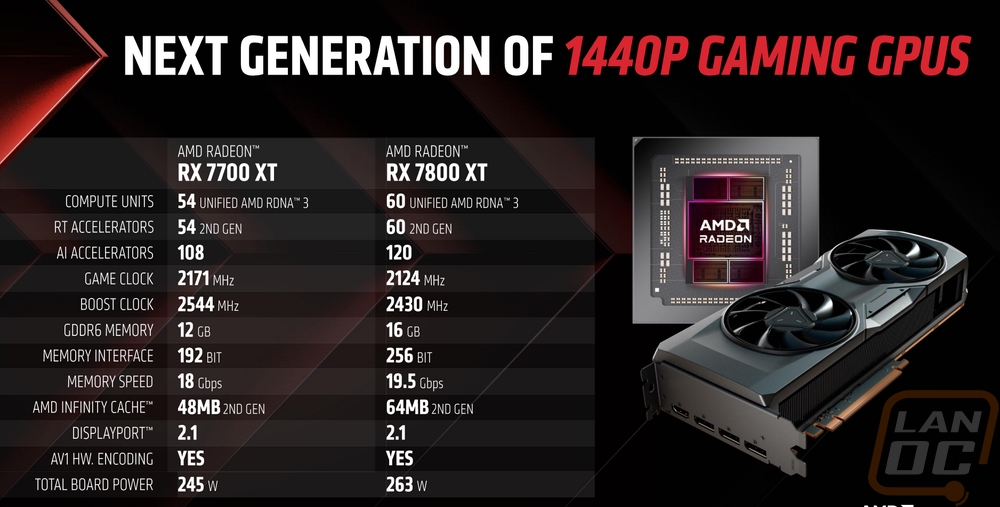
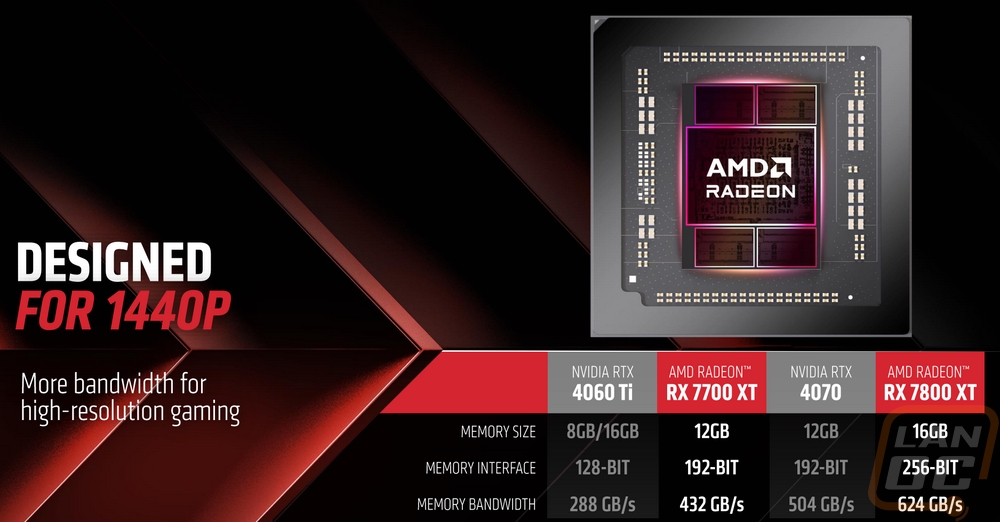
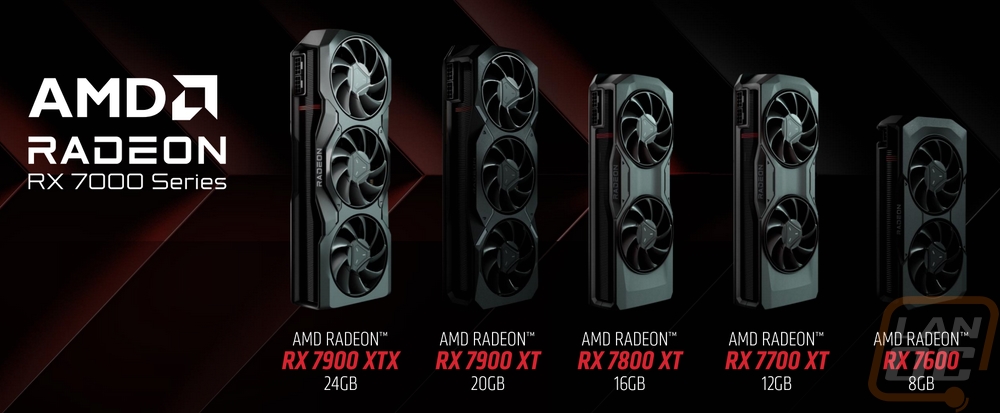
Alongside of the two new cards, AMD also announced their FidelityFX Super Resolution 3 which brings frame generation to AMD cards. Unlike DLSS from Nvidia AMD has this as an open standard so it can not only work with all of AMDs cards, but it can also work with Nvidia cards as well. FSP 3 with upscaling can work with AMD cards back to the RX 590 and Nvidia 10 Series cards but that doesn’t include frame generation. For that, you will need an AMD 5700 or better and RTX 20 Series or higher. They showed off the performance differences that you can see with Forspoken from Square Enix where they were able to go from 36 FPS up to 122 FPS at 4K by using FSR 3 performance mode. FSR 3 has a list of upcoming games and game support of course will make or break this as a feature. The performance is great, but if none of the games you play support It, well that doesn’t help at all. FSR and FSR 2 have 300 games with current or upcoming support so if that is any indication. They also have combined Radeon Boost, Anti-Lag+, and Super Resolution on the driver side into one feature they are calling Hyper-RX which helps make getting better performance easier, with that they showed off some performance improvements you can see with average FPS improving and latency dropping by big margins in all of the games shown.
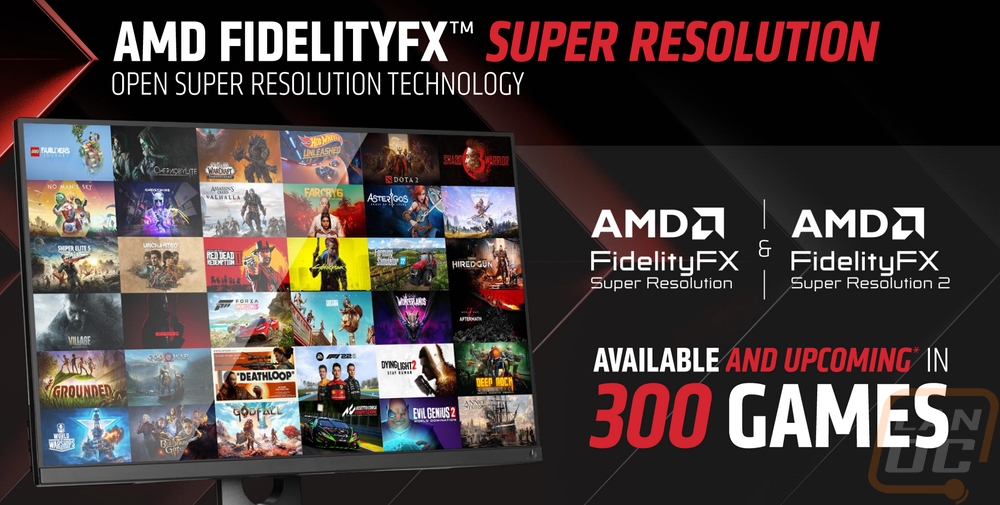
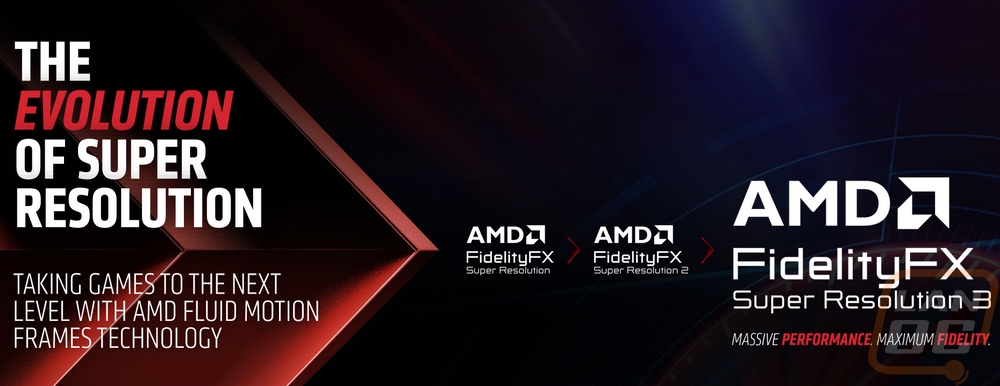
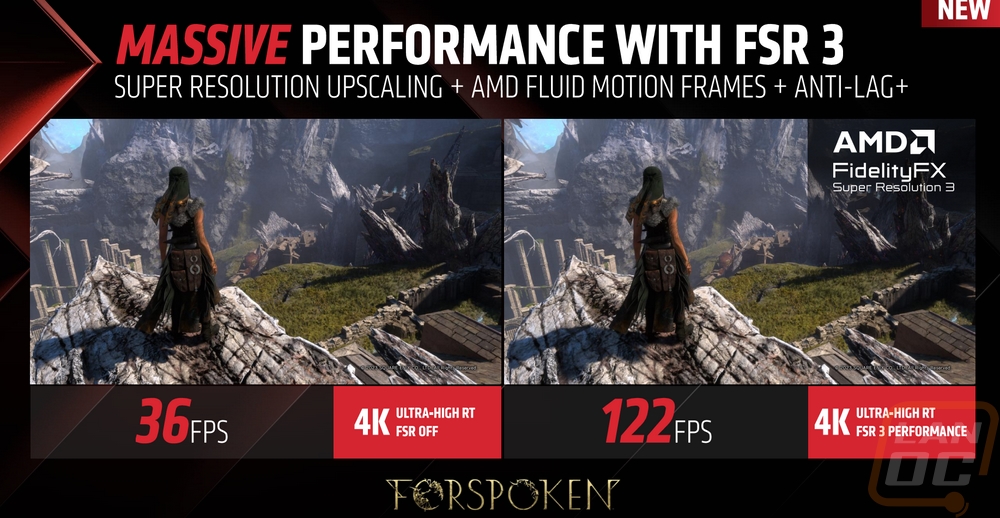
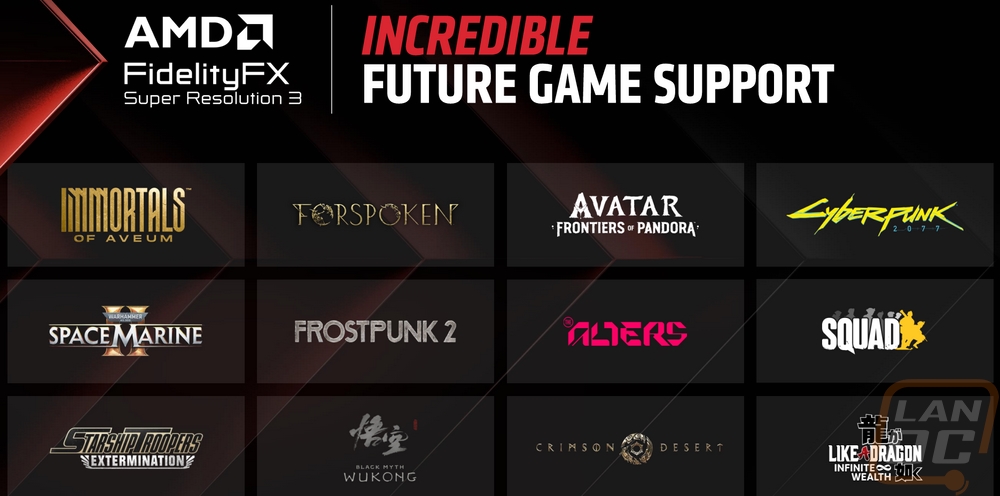
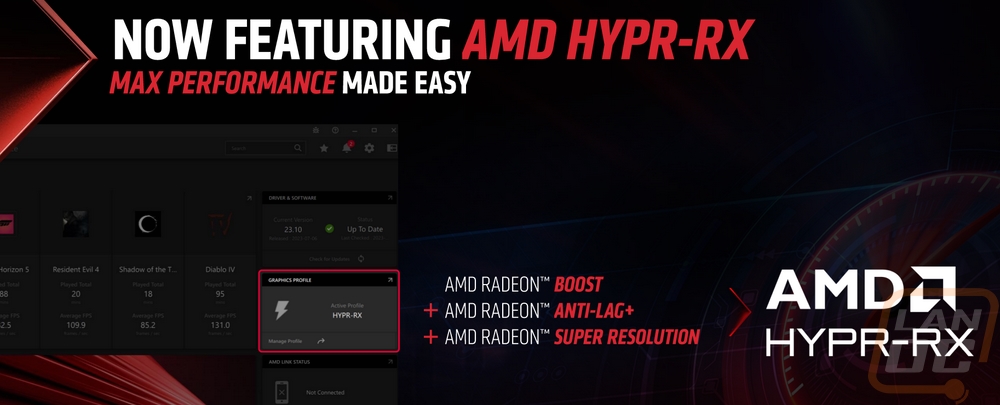
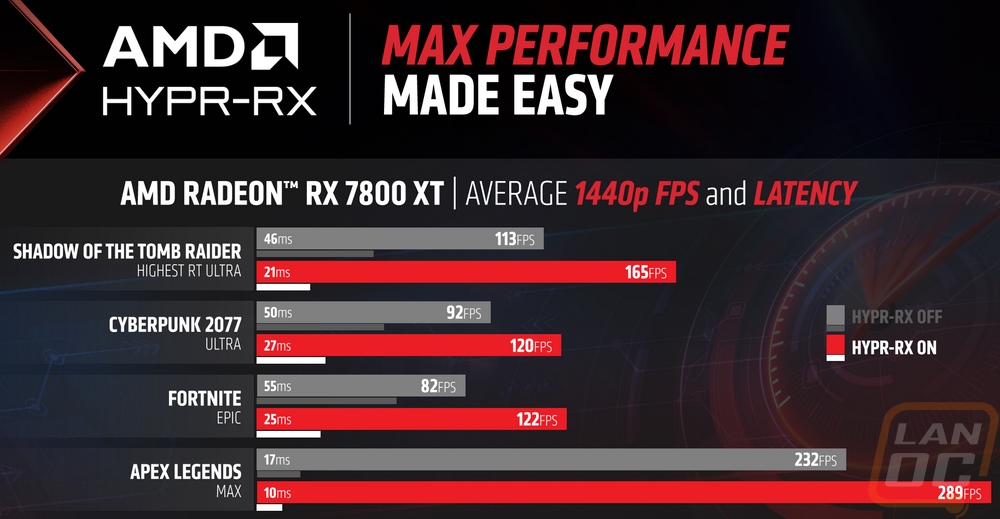
AMD also touched on the streaming capabilities as well on their call. Highlighting AV1 support which is the future of streaming. AV1 can get you higher quality while lowering the bandwidth needs. They also touched on AMDs noise suppression which can help cut out background noise from your microphone.
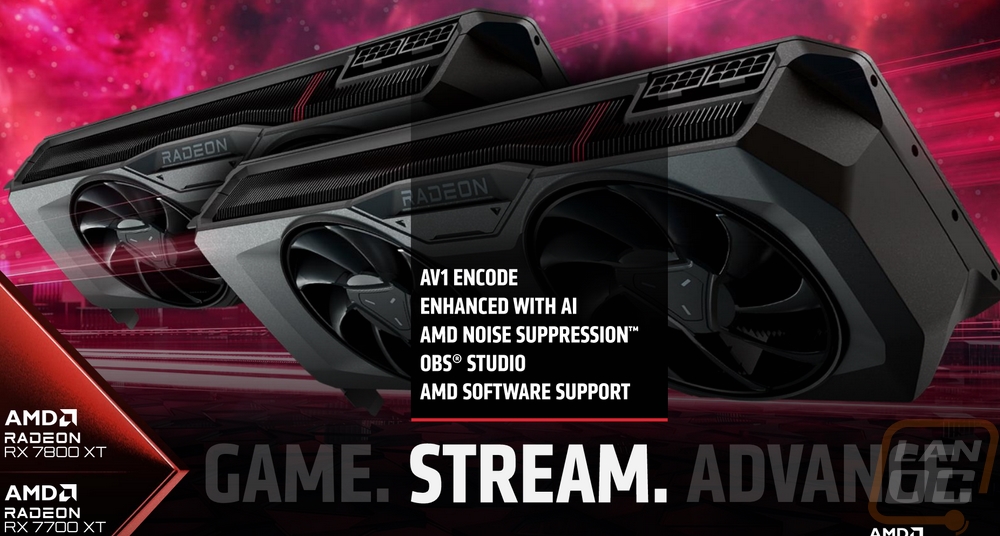
With the RX 7700 XT and RX 7800 XT hitting stores tomorrow September 6th, the cards are also timed to launch the same day as Starfield which utilizes AMDs technology. AMD is also offering a copy of the game to anyone who picks up the 7700 XT or the 7800 XT. This is a great way to add some value to the cards and also make sure everyone has access to a brand new game to check out how your new cards can perform.
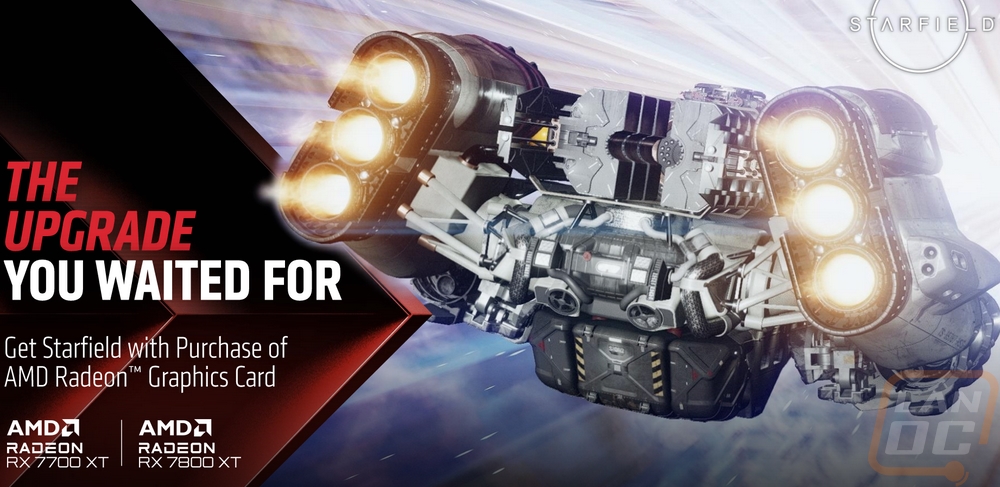
Before getting into testing I did also run GPUz to double-check that our clock speeds matched up with the specifications. The Radeon RX 7800 XT I previous took a look at had the stock clock speed of 2124 default and 2430 MHz for the boost clock. The XFX Merc 319 7800 XT Black is however is overclocked and with that, its boost clock speed is 2565 MHz and the game clock is 2254 MHz which is spot on. This does also document the driver I tested on which is the Adrenalin 23.20.01.05 driver that AMD sent out ahead of the launch and it documents the BIOS revision as well.

|
XFX Merc 319 7800 XT Black Specifications |
|
|
Model Number |
RX-78TMERCB9 |
|
Product Description |
XFX SPEEDSTER MERC319 RADEON RX 7800 XT BLACK Gaming Graphics Card with 16GB GDDR6 HDMI 3xDP, AMD RDNATM 3 |
|
Card Dimension (cm) |
32.6 x12.6 x5.8 |
|
Card Dimension (inch) |
12.83 x 4.96 x 2.28 |
|
Card Profile |
2.75 Slot |
|
DUAL BIOS Setting |
Right: OC: 236w Factory Default Setting Game Clk: up to 2254MHz Boost Clk: up to 2565MHz Note: Right BIOS is the position closest to I/O shield. Left: OC: 236w Backup Bios Game Clk: up to 2254MHz Boost Clk: up to 2565MHz Note: There is no difference in BIOS positions at this time |
|
Thermal Solution |
3 Fan w/ Vapor Chamber |
|
Memory Type |
GDDR6 |
|
Memory Size |
16 GB |
|
Memory Clock |
19.5 Gbps |
|
Memory Bus |
256 bit |
|
Compute Units |
60 |
|
Stream Processors |
3840 |
|
Bus Type |
PCI-E 4.0 |
|
TGP |
236w |
|
Warranty |
3 Years with product registration |


